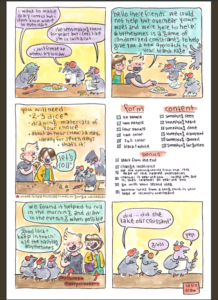After reading Percival Everett’s poem “Zulus” from re: f (gesture) one might be confused by the abstract and nonsensical content of each poem from poems A-Z. I too shared this belief after reading the poems for the first time in class. However, after applying some background knowledge and using online resources a reader is able to better understand what Percival Everett is trying to convey.
To begin with, a reader must analyze Everett’s use of literary devices used in each of his poems. Everett uses repetition of a certain letter in his poems A-Z to better convey his message. This is done by using words that begin with the same first letter to express his message. Everett also uses multiple allusions referring to ancient mythology from various cultures, as well as allusions to religion, historical figures, pop culture, literary figures, movies, and many more. Everett’s use of allusions helps to reinforce the subject of each poem (A is for… and so on), as well as progressing his use of repetition, allusions of words or phrases that share the beginning letter of the word of phrase, with the subject of the poem. Another important allusion Everett continuously utilizes throughout his poem is the use of diverse languages. Most of the poem is written in English, however Everett also incorporates Latin, Spanish, French, and German. The trend of these two literary devices are mostly consistent and play an important role in Everett’s message.
So what exactly is Percival Everett’s message?
I believe Everett’s message is actually different in each poem. To simplify, I believe that Everett’s A poem has a different message than Everett’s B poem. I believe Everett wrote his poems with this idea in mind, because he wanted to express his own thoughts on certain subjects (society, war, religion, power, etc.) which is reflected through his allusions.
For example, I analyzed Everett’s poem for the letter U.
U is for Anaximander’s Boundless.
For Upanishads, oh Maya,
Oh Maya, how high the skya.
Thether her umbilically
From the planet and
Float her out to space.
U is for Urban II’s call
For the big and nasty bloody.
In the Name of God,
Und so weiter
In the first stanza, Everett references Anaximander being boundless. This is an allusion to the ancient Greek philosopher Anaximander known as the “Father of Cosmology”, whose thoughts and ideas on cosmology were some of the earliest and first non-mythological. The “Boundless” alluded to may refer to the boundlessness of space, the subject of Anaximander’s teachings. On a side note, Everett uses Anaximander and Boundlessness as an allusion in his first poem for the letter A.
The second stanza mentions the Upanishads, an important scripture of the Hindu religion. In Hinduism, the Upanishads are a set of mystical and philosophical texts that were responsible for the development of spiritualism for Hindus. The Upanishads hold a crucial role for not just Hindus, but Buddhists as well who share spiritual practices. This leads to the second part of the stanza where Everett mentions Maya. I believe the Maya Everett is referencing is the mother of Buddha. If so, Everett is alluding to the strong connection between the Hindu and the Buddhist religions.
In stanzas three through six, Everett again mentions Maya (the mother of Buddha) with allusions to the sky and space. I expect Everett’s hyperbole for thethering Maya to the planet and having her float into space is a metaphor for Buddha, who was in Maya’s womb and was able to eventually reach nirvana which in this case is represented by space (boundless).
The last stanzas seven through ten allude to Pope Urban II and his call for the big and nasty bloody. This is a reference to Urban II’s call for the first crusade to aid the Byzantine empire and reclaim the holy lands. The first crusade saw heavy losses for both Europeans and Moors. This was all caused by Pope Urban II whose call was claimed “in the name of God”, as Everett states. The final stanza is German and translates “and so on”. I believe Everett included this translation to exclaim that Pope Urban II’s call for the crusades was not really in the name of God, but for a personal intent for himself.
After analyzing the stanzas of the poem, I came to the conclusion that Everett’s U poem reflects his thoughts on religion. Everett’s allusion to these historical figures demonstrate his own conceived perspective of religion, shown through different religions (Christianity, Buddhism, and Hinduism). Religion can be seen as liberating and boundless (Anaximander and Maya) or it can be used for something horrible (Urbans II’s call for a crusade). Poem U’s theme of religion marks just one of the self- reflections Everett demonstrates through his poem “Zulus”.
Overall, this is just one interpretation of Percival Everett’s writing. As students with knowledge of Percival Everett and his writing we know that Everett is unpredictable and his meaning behind his writing is something that only he can unpack.
The biggest observation I gathered after reading “Zulus” is that Percival Everett is highly trained in interdisciplinary writing, as he is able to make connections between a wide range of subjects. This is exemplified again through his varying allusions used in his poems. This shows Percival Everett as an accomplished writer, capable of reflecting his own thoughts and perspectives.


